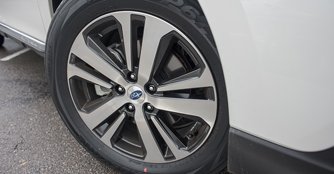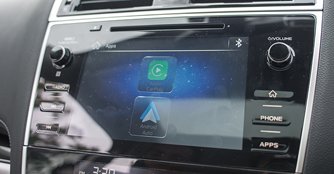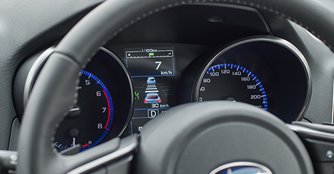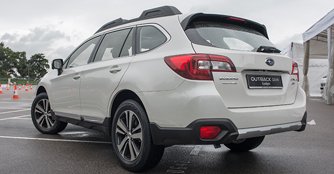Subaru Outback 2.5i-S EyeSight First Drive Review
24 Jan 2018|15,325 views
Facelift (What's New)
Subaru EyeSight driver assist technology
Facelifted bumpers and head lights
8.0-inch infotainment display with Apple CarPlay and Android Auto connectivity
In an industry increasingly dominated by crossovers and sport utility vehicles, the Subaru Outback faces consistently stiff competition. For 2018, the Outback has undergone a facelift, which brings with it a slew of improvements, headlined by the availability of Subaru's EyeSight driver assist technology.
Light touch up
Visually, the Outback retains its sleek, wagon-like profile. The facelifted model features refreshed front and rear bumpers, as well as a new, darkened hexagonal grille. The car also comes equipped with LED headlamps with steering responsive head lights, which move in accordance to how the car is steered. The other notable change is the newly-designed, lightweight turbine-shaped rims.
The updated interior features an improved infotainment system - the high-resolution display has grown an inch to 8.0-inches, and now supports Apple CarPlay and Android Auto.
Of course, a crossover is all about practicality and functionality, and the facelifted Outback features a host of quality of life improvements. USB ports have been added to the back of the centre console, and there are now two microphones to improve voice recognition, just to name a couple.
At the rear, the trunk opening time when using the access key has been reduced from two seconds to 1.2 seconds. To improve convenience, the trunk can now be opened without holding the access key if all the doors have already been unlocked. Additionally, in order to improve anti-theft security, the trunk locks when the car starts driving, and cannot be opened again from the outside without the access key until the next time a door is opened.
Safer and smarter
Mechanically, the Outback remains fundamentally unchanged - a 2.5-litre Boxer engine producing 173bhp and 235Nm of torque is mated to a Continuously Variable Transmission (CVT). There have been some tweaks to the engine, such as a new alternator that weighs eight percent less, to improve fuel efficiency.
Light touch up
Visually, the Outback retains its sleek, wagon-like profile. The facelifted model features refreshed front and rear bumpers, as well as a new, darkened hexagonal grille. The car also comes equipped with LED headlamps with steering responsive head lights, which move in accordance to how the car is steered. The other notable change is the newly-designed, lightweight turbine-shaped rims.
The updated interior features an improved infotainment system - the high-resolution display has grown an inch to 8.0-inches, and now supports Apple CarPlay and Android Auto.
Of course, a crossover is all about practicality and functionality, and the facelifted Outback features a host of quality of life improvements. USB ports have been added to the back of the centre console, and there are now two microphones to improve voice recognition, just to name a couple.
At the rear, the trunk opening time when using the access key has been reduced from two seconds to 1.2 seconds. To improve convenience, the trunk can now be opened without holding the access key if all the doors have already been unlocked. Additionally, in order to improve anti-theft security, the trunk locks when the car starts driving, and cannot be opened again from the outside without the access key until the next time a door is opened.
Safer and smarter
Mechanically, the Outback remains fundamentally unchanged - a 2.5-litre Boxer engine producing 173bhp and 235Nm of torque is mated to a Continuously Variable Transmission (CVT). There have been some tweaks to the engine, such as a new alternator that weighs eight percent less, to improve fuel efficiency.
The CVT now has a seven-speed manual mode, and the throttle response has been improved to create a sporty acceleration feel. Changing the CVT chain to a short pitch chain has also reduced cabin noise, and fuel efficiency has been improved by approximately three percent compared to the previous model.
The big news is that the Outback is now available with Subaru EyeSight, which comprises Adaptive Cruise Control, Lane Sway and Departure Warning, Lead Vehicle Start Alert, Pre-Collision Braking System and Pre-Collision Throttle Management. While not particularly revolutionary considering that several European car manufacturers already have these features in their vehicles, the availability of EyeSight offers buyers a more premium experience and a greater peace of mind.
One feature we particularly liked is the braking indicators when cruise control is activated. When the car autonomously brakes for you, the brake lights on the dashboard graphic light up as well. This visual indication helps give you a better sense of what's happening at all times.
A better all-around experience
The Outback very much looks and feels the same, all things considered, and that's not a bad thing. All the various micro-enhancements help the car feel more premium and modern than before.
Unfortunately, as our brief drive of the car was conducted in a controlled environment, we can't definitively tell you about the road-going functionality of the EyeSight, though all signs seem promising. For our full impressions of the updated Outback, you'll have to wait until we take the car out for an extensive road test.
The big news is that the Outback is now available with Subaru EyeSight, which comprises Adaptive Cruise Control, Lane Sway and Departure Warning, Lead Vehicle Start Alert, Pre-Collision Braking System and Pre-Collision Throttle Management. While not particularly revolutionary considering that several European car manufacturers already have these features in their vehicles, the availability of EyeSight offers buyers a more premium experience and a greater peace of mind.
One feature we particularly liked is the braking indicators when cruise control is activated. When the car autonomously brakes for you, the brake lights on the dashboard graphic light up as well. This visual indication helps give you a better sense of what's happening at all times.
A better all-around experience
The Outback very much looks and feels the same, all things considered, and that's not a bad thing. All the various micro-enhancements help the car feel more premium and modern than before.
Unfortunately, as our brief drive of the car was conducted in a controlled environment, we can't definitively tell you about the road-going functionality of the EyeSight, though all signs seem promising. For our full impressions of the updated Outback, you'll have to wait until we take the car out for an extensive road test.
Facelift (What's New)
Subaru EyeSight driver assist technology
Facelifted bumpers and head lights
8.0-inch infotainment display with Apple CarPlay and Android Auto connectivity
In an industry increasingly dominated by crossovers and sport utility vehicles, the Subaru Outback faces consistently stiff competition. For 2018, the Outback has undergone a facelift, which brings with it a slew of improvements, headlined by the availability of Subaru's EyeSight driver assist technology.
Light touch up
Visually, the Outback retains its sleek, wagon-like profile. The facelifted model features refreshed front and rear bumpers, as well as a new, darkened hexagonal grille. The car also comes equipped with LED headlamps with steering responsive head lights, which move in accordance to how the car is steered. The other notable change is the newly-designed, lightweight turbine-shaped rims.
The updated interior features an improved infotainment system - the high-resolution display has grown an inch to 8.0-inches, and now supports Apple CarPlay and Android Auto.
Of course, a crossover is all about practicality and functionality, and the facelifted Outback features a host of quality of life improvements. USB ports have been added to the back of the centre console, and there are now two microphones to improve voice recognition, just to name a couple.
At the rear, the trunk opening time when using the access key has been reduced from two seconds to 1.2 seconds. To improve convenience, the trunk can now be opened without holding the access key if all the doors have already been unlocked. Additionally, in order to improve anti-theft security, the trunk locks when the car starts driving, and cannot be opened again from the outside without the access key until the next time a door is opened.
Safer and smarter
Mechanically, the Outback remains fundamentally unchanged - a 2.5-litre Boxer engine producing 173bhp and 235Nm of torque is mated to a Continuously Variable Transmission (CVT). There have been some tweaks to the engine, such as a new alternator that weighs eight percent less, to improve fuel efficiency.
Light touch up
Visually, the Outback retains its sleek, wagon-like profile. The facelifted model features refreshed front and rear bumpers, as well as a new, darkened hexagonal grille. The car also comes equipped with LED headlamps with steering responsive head lights, which move in accordance to how the car is steered. The other notable change is the newly-designed, lightweight turbine-shaped rims.
The updated interior features an improved infotainment system - the high-resolution display has grown an inch to 8.0-inches, and now supports Apple CarPlay and Android Auto.
Of course, a crossover is all about practicality and functionality, and the facelifted Outback features a host of quality of life improvements. USB ports have been added to the back of the centre console, and there are now two microphones to improve voice recognition, just to name a couple.
At the rear, the trunk opening time when using the access key has been reduced from two seconds to 1.2 seconds. To improve convenience, the trunk can now be opened without holding the access key if all the doors have already been unlocked. Additionally, in order to improve anti-theft security, the trunk locks when the car starts driving, and cannot be opened again from the outside without the access key until the next time a door is opened.
Safer and smarter
Mechanically, the Outback remains fundamentally unchanged - a 2.5-litre Boxer engine producing 173bhp and 235Nm of torque is mated to a Continuously Variable Transmission (CVT). There have been some tweaks to the engine, such as a new alternator that weighs eight percent less, to improve fuel efficiency.
The CVT now has a seven-speed manual mode, and the throttle response has been improved to create a sporty acceleration feel. Changing the CVT chain to a short pitch chain has also reduced cabin noise, and fuel efficiency has been improved by approximately three percent compared to the previous model.
The big news is that the Outback is now available with Subaru EyeSight, which comprises Adaptive Cruise Control, Lane Sway and Departure Warning, Lead Vehicle Start Alert, Pre-Collision Braking System and Pre-Collision Throttle Management. While not particularly revolutionary considering that several European car manufacturers already have these features in their vehicles, the availability of EyeSight offers buyers a more premium experience and a greater peace of mind.
One feature we particularly liked is the braking indicators when cruise control is activated. When the car autonomously brakes for you, the brake lights on the dashboard graphic light up as well. This visual indication helps give you a better sense of what's happening at all times.
A better all-around experience
The Outback very much looks and feels the same, all things considered, and that's not a bad thing. All the various micro-enhancements help the car feel more premium and modern than before.
Unfortunately, as our brief drive of the car was conducted in a controlled environment, we can't definitively tell you about the road-going functionality of the EyeSight, though all signs seem promising. For our full impressions of the updated Outback, you'll have to wait until we take the car out for an extensive road test.
The big news is that the Outback is now available with Subaru EyeSight, which comprises Adaptive Cruise Control, Lane Sway and Departure Warning, Lead Vehicle Start Alert, Pre-Collision Braking System and Pre-Collision Throttle Management. While not particularly revolutionary considering that several European car manufacturers already have these features in their vehicles, the availability of EyeSight offers buyers a more premium experience and a greater peace of mind.
One feature we particularly liked is the braking indicators when cruise control is activated. When the car autonomously brakes for you, the brake lights on the dashboard graphic light up as well. This visual indication helps give you a better sense of what's happening at all times.
A better all-around experience
The Outback very much looks and feels the same, all things considered, and that's not a bad thing. All the various micro-enhancements help the car feel more premium and modern than before.
Unfortunately, as our brief drive of the car was conducted in a controlled environment, we can't definitively tell you about the road-going functionality of the EyeSight, though all signs seem promising. For our full impressions of the updated Outback, you'll have to wait until we take the car out for an extensive road test.
Thank You For Your Subscription.

































